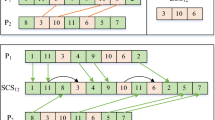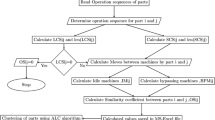Abstract
Delayed reconfigurable manufacturing system (D-RMS), a subclass of reconfigurable manufacturing system (RMS), were proposed to solve the convertibility problems of RMS. As a part family-oriented manufacturing system paradigm, D-RMS should concern delayed reconfiguration at the outset of part family formation. To bring the characteristics of delayed reconfiguration into the part family of D-RMS, an exclusive part family formation method for D-RMS based on machine learning is proposed in this paper. Firstly, a similarity coefficient that considers the characteristics of D-RMS is put forward based on the operation sequence of part. The positions of the common operations in the corresponding operation sequences are investigated. The more former common operations there are, the more probability it is that the parts are grouped into the same part family. The relative positions of the common operations are considered by proposing a concept of the longest relative position common operation subsequence (LPCS). Additionally, the position difference and discontinuity of the LPCSs in the corresponding operation sequences are analyzed. A similarity coefficient is proposed that incorporates the abovementioned factors. Secondly, a machine learning method named K-medoids is adopted to group parts into families based on the calculation result of the similarity coefficient. Finally, a case study is presented to implement the proposed part family formation method for D-RMS, where the effectiveness of the proposed method is verified through comparison.
















Similar content being viewed by others
References
Abdi, M. R. (2012). Product family formation and selection for reconfigurability using analytical network process. International Journal of Production Research, 50(17), 4908–4921.
Abdi, M. R., & Labib, A. W. (2004). Grouping and selecting products: The design key of reconfigurable manufacturing systems (RMSs). International Journal of Production Research, 42(3), 521–546.
Alonso-Perez, J. L., Cardenas-Maciel, S. L., Trujillo-Navarrete, B., et al. (2021). An approach for designing smart manufacturing for the research and development of dye-sensitize solar cell. Journal of Intelligent Manufacturing, 171, 1–14.
Ameer, M., & Dahane, M. (2021). Reconfigurability improvement in Industry 4.0: A hybrid genetic algorithm-based heuristic approach for a co-generation of setup and process plans in a reconfigurable environment. Journal of Intelligent Manufacturing, 7, 1–23.
Ashraf, M., & Hasan, F. (2015). Product family formation based on multiple product similarities for a reconfigurable manufacturing system. International Journal of Modelling in Operations Management, 5(3–4), 247–265.
Askin, R. G., & Zhou, M. (1998). Formation of independent flow-line cells based on operation requirements and machine capabilities. IIE Transactions, 30(4), 319–329.
Bortolini, M., Galizia, F. G., & Mora, C. (2018). Reconfigurable manufacturing systems: Literature review and research trend. Journal of Manufacturing Systems, 49, 93–106.
Choobineh, F. (1988). A framework for the design of cellular manufacturing systems. International Journal of Production Research, 26(7), 1161–1172.
Ezzat, O., Medini, K., Boucher, X., et al. (2022). A clustering approach for modularizing service-oriented systems. Journal of Intelligent Manufacturing, 33, 719–734.
Farid, A. M. (2017). Measures of reconfigurability and its key characteristics in intelligent manufacturing systems. Journal of Intelligent Manufacturing, 28(2), 353–369.
Gauss, L., Lacerda, D. P., & Cauchick Miguel, P. A. (2021). Module-based product family design: Systematic literature review and meta-synthesis. Journal of Intelligent Manufacturing, 32(1), 265–312.
Goyal, K. K., Jain, P. K., & Jain, M. (2013). A comprehensive approach to operation sequence similarity based part family formation in the reconfigurable manufacturing system. International Journal of Production Research, 51(6), 1762–1776.
Gupta, A., Jain, P. K., & Kumar, D. (2014). Part family formation for reconfigurable manufacturing system using K-means algorithm. International Journal of Internet Manufacturing and Services, 3(3), 244–262.
Hasan, S. M., Baqai, A. A., Butt, S. U., et al. (2018). Product family formation based on complexity for assembly systems. The International Journal of Advanced Manufacturing Technology, 95(1), 569–585.
Ho, Y. C., Lee, C. C., & Moodie, C. L. (1993). Two sequence-pattern, matching-based, flow analysis methods for multi-flowlines layout design. International Journal of Production Research, 31(7), 1557–1578.
Huang, S., Wang, G., Lei, D., et al. (2022). Toward digital validation for rapid product development based on digital twin: A framework. The International Journal of Advanced Manufacturing Technology, 119, 1–15.
Huang, S., Wang, G., Shang, X., et al. (2018a). Reconfiguration point decision method based on dynamic complexity for reconfigurable manufacturing system (RMS). Journal of Intelligent Manufacturing, 29(5), 1031–1043.
Huang, S., Wang, G., Yan, Y., et al. (2018b). Similarity coefficient of RMS part family grouping considering reconfiguration efforts. IEEE Access, 6, 71871–71883.
Huang, S., Wang, G., & Yan, Y. (2019). Delayed reconfigurable manufacturing system. International Journal of Production Research, 57(8), 2372–2391.
Huang, S., & Yan, Y. (2019). Part family grouping method for reconfigurable manufacturing system considering process time and capacity demand. Flexible Services and Manufacturing Journal, 31(2), 424–445.
Kashkoush, M., & ElMaraghy, H. (2014). Product family formation for reconfigurable assembly systems. Procedia CIRP, 17, 302–307.
Khanna, K., & Kumar, R. (2017). Part family and operations group formation for RMS using bond energy algorithm. International Journal of Engineering and Technology, 9(2), 1365–1373.
Koren, Y., Gu, X., & Guo, W. (2017). Reconfigurable manufacturing systems: Principles, design, and future trends. Frontiers of Mechanical Engineering, 13(2), 121–136.
Koren, Y., Gu, X., & Guo, W. (2018). Choosing the system configuration for high-volume manufacturing. International Journal of Production Research, 56(1–2), 476–490.
Koren, Y., Heisel, U., Jovane, F., et al. (1999). Reconfigurable manufacturing system. CIRP Annals - Manufacturing Technology, 48(2), 527–540.
Maganha, I., Silva, C., & Ferreira, L. M. D. (2018). Understanding reconfigurability of manufacturing systems: An empirical analysis. Journal of Manufacturing Systems, 48, 120–130.
Massimi, E., Khezri, A., Benderbal, H. H., et al. (2020). A heuristic-based non-linear mixed integer approach for optimizing modularity and integrability in a sustainable reconfigurable manufacturing environment. The International Journal of Advanced Manufacturing Technology, 108, 1997–2020.
Mehrabi, M. G., Ulsoy, A. G., Koren, Y., et al. (2002). Trends and perspectives in flexible and reconfigurable manufacturing systems. Journal of Intelligent Manufacturing, 13(2), 135–146.
Montalto, A., Graziosi, S., Bordegoni, M., et al. (2020). An approach to design reconfigurable manufacturing tools to manage product variability: The mass customisation of eyewear. Journal of Intelligent Manufacturing, 31(1), 87–102.
Mukattash, A., Dahmani, N., Al-Bashir, A., et al. (2018). Comprehensive grouping efficacy: A new measure for evaluating block-diagonal forms in group technology. International Journal of Industrial Engineering Computations, 9(1), 155–172.
Park, H. S., & Jun, C. H. (2009). A simple and fast algorithm for K-medoids clustering. Expert Systems with Applications, 36(2), 3336–3341.
Rajesh, K. D., Krishna, M. M., Ali, M. A., et al. (2017). A modified hybrid similarity coefficient based method for solving the cell formation problem in cellular manufacturing system. Materials Today: Proceedings, 4(2), 1469–1477.
Rakesh, K., Jain, P. K., & Mehta, N. K. (2010). A framework for simultaneous recognition of part families and operation groups for driving a reconfigurable manufacturing system. Advances in Production Engineering & Management Journal, 5(1), 45–58.
Selim, H. M., Aal, R. M. A., & Mahdi, A. I. (2003). Formation of machine groups and part families: A modified SLC method and comparative study. Integrated Manufacturing Systems, 14(2), 123–137.
Tam, K. Y. (1990). An operation sequence based similarity coefficient for part families formation. Journal of Manufacturing Systems, 9(1), 55–67.
Tang, L., & Meng, Y. (2021). Data analytics and optimization for smart industry. Frontiers of Engineering Management, 8(2), 157–171.
Ulutas, B. H. (2019). An immune system based algorithm for cell formation problem. Journal of Intelligent Manufacturing, 30(8), 2835–2852.
Vakharia, A. J., & Wemmerlov, U. (1990). Designing a cellular manufacturing system: A materials flow approach based on operation sequences. IIE Transactions, 22(1), 84–97.
Wang, G. X., Huang, S. H., Shang, X. W., et al. (2016). Formation of part family for reconfigurable manufacturing systems considering bypassing moves and idle machines. Journal of Manufacturing Systems, 41, 120–129.
Wang, K., Jiang, Z., Peng, B., et al. (2021). Servitization of manufacturing in the new ICTs era: A survey on operations management. Frontiers of Engineering Management, 8(2), 223–235.
Xu, H., Liu, Q., Casillas, J., et al. (2020). Prediction of cell viability in dynamic optical projection stereolithography-based bioprinting using machine learning. Journal of Intelligent Manufacturing, 33, 1–11.
Yao, X., Zhou, J., Lin, Y., et al. (2019). Smart manufacturing based on cyber-physical systems and beyond. Journal of Intelligent Manufacturing, 30(8), 2805–2817.
Zerrougui, R., Adamou-Mitiche, A. B., & Mitiche, L. (2022). A novel machine learning algorithm for interval systems approximation based on artificial neural network. Journal of Intelligent Manufacturing. https://doi.org/10.1007/s10845-021-01874-0
Zhang, Q., Liao, B., & Yang, S. (2020). Application of blockchain in the field of intelligent manufacturing: Theoretical basis, realistic plights, and development suggestions. Frontiers of Engineering Management, 7(4), 578–591.
Zheng, P., Xu, X., & Chen, C. H. (2020). A data-driven cyber-physical approach for personalised smart, connected product co-development in a cloud-based environment. Journal of Intelligent Manufacturing, 31(1), 3–18.
Zhou, Y., Wang, L., Ding, L., et al. (2020). Intelligent technologies help operating mobile cabin hospitals effectively cope with COVID-19. Frontiers of Engineering Management, 7(3), 459–460.
Acknowledgements
The authors are grateful to the anonymous reviewers and the editor for their comments and feedback, which helped us to improve this paper. All the authors have approved this manuscript for submission to the journal, and there are no conflicts of interest regarding the publication of this manuscript. The authors acknowledge the supporting fund, the China National Postdoctoral Program for Innovative Talents (Grant No. BX20200053), the National Natural Science Foundation of China (Grant No. 51975056) and the China Postdoctoral Science Foundation (Grant No. 2021M700420).
Author information
Authors and Affiliations
Corresponding author
Additional information
Publisher's Note
Springer Nature remains neutral with regard to jurisdictional claims in published maps and institutional affiliations.
Rights and permissions
About this article
Cite this article
Huang, S., Wang, G., Nie, S. et al. Part family formation method for delayed reconfigurable manufacturing system based on machine learning. J Intell Manuf 34, 2849–2863 (2023). https://doi.org/10.1007/s10845-022-01956-7
Received:
Accepted:
Published:
Issue Date:
DOI: https://doi.org/10.1007/s10845-022-01956-7




